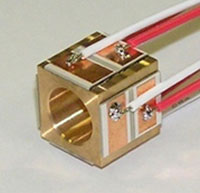Piezoelectric actuators: Why cubic?

An actual cubic actuator <br>Copyright : TUT<br><br>
Here, Tomoaki Mashimo and Shigeki Toyama analyzed the vibrational behavior of cubic stators based on an energy method, which distinguishes components of mechanical energy.
By changing the design of stators—especially the length in the direction of the through-hole axis—the researchers clarified how the vibrational modes are in accordance at one equal frequency in cubic shape.
The energy method described in this paper showed that the mechanical energy of two specific vibrational modes is in equilibrium. The shape for which the stator achieves equilibrium energy was found to be a cube.
This approach should be useful for not only studies on vibration, but also for design the stators with an easy-to-use modal analysis method.
Reference:
Tomoaki Mashimo and Shigeki Toyama.
Vibration Analysis of Cubic Rotary-Linear Piezoelectric Actuator.
IEEE Transactions on Ultrasonics, Ferroelectrics, and Frequency Control 58, 844–848, (2011).
Digital Object Identifier (DOI): 10.1109/TUFFC.2011.1877
Tomoaki Mashimo is now at the Electronics-Inspired Interdisciplinary Research Institute, Toyohashi University of Technology.
Department website: Electronics-Inspired Interdisciplinary Research Institute (EIIRIS) http://www.eiiris.tut.ac.jp/
Media Contact
All latest news from the category: Power and Electrical Engineering
This topic covers issues related to energy generation, conversion, transportation and consumption and how the industry is addressing the challenge of energy efficiency in general.
innovations-report provides in-depth and informative reports and articles on subjects ranging from wind energy, fuel cell technology, solar energy, geothermal energy, petroleum, gas, nuclear engineering, alternative energy and energy efficiency to fusion, hydrogen and superconductor technologies.
Newest articles

Security vulnerability in browser interface
… allows computer access via graphics card. Researchers at Graz University of Technology were successful with three different side-channel attacks on graphics cards via the WebGPU browser interface. The attacks…

A closer look at mechanochemistry
Ferdi Schüth and his team at the Max Planck Institut für Kohlenforschung in Mülheim/Germany have been studying the phenomena of mechanochemistry for several years. But what actually happens at the…

Severe Vulnerabilities Discovered in Software to Protect Internet Routing
A research team from the National Research Center for Applied Cybersecurity ATHENE led by Prof. Dr. Haya Schulmann has uncovered 18 vulnerabilities in crucial software components of Resource Public Key…





















